SolidRun has designed and manufactured ClearFog networking boards ever since the introduction of the Marvell ARMADA 380/388-based ClearFog Pro in 2015. Since then, more powerful models have been launched including the ClearFog GT 8K based on Marvell ARMADA A8040 quad-core Cortex A72 processor with support for 2.5GbE and 10GbE, and the ClearFog CX LX2K equipped with a 16-core Cortex-A72 NXP capable of 100GbE networking.
The Israeli company unveiled its first Octeon TX2-based design last fall with ClearFog CX CN9K, a full-featured networking SBC fitted with CEx7 CN9132 COM Express Type 7 module. But now the company has launched the more compact ClearFog CN9130 Pro/Base networking boards equipped with a tiny 50x30mm Octeon TX2 module still enabling 10GbE connectivity.
SolidRun SOM 9130 system-on-module
- SoC – Marvell OCTEON TX2 CN9130 quad-core Cortex A72 processor @ up to 2.2 GHz (commercial) or 2.0 GHz (industrial)
- System Memory – Up to 8GB DDR4 RAM
- Storage – 8GB eMMC flash, 64Mbit SPI flash
- 3 x Hirose DF40 board-to-board connectors with
- External Storage – NOR Flash, SD card, PCIe-SSD, 2x SATA III (via configurable SERDES)
- Ethernet
- 1x 10/5 GbE port
- 2x 1/2.5 GbE Port (via configurable SERDES)
- 2x 5 GbE Port
- 1x 1/2.5 GbE Port
- Support for Sync-E (Synchronous Ethernet), 1588-V2 precision time protocol
- USB – 2x USB 2.0 interfaces, up to 2 USB 3.0 host/device interfaces (via configurable SERDES)
- PCIe
- 1x PCIe Gen 3.0 x4
- 2x PCIE Gen 3.0 x1 (via configurable SERDES)
- Total of 3 controllers and up to 6 lanes
- 2x I2C, 1x SPI, 2x UART
- GPIO, PWM
- JTAG
- I/O Voltage – 3.3V/1.8V
- Supply Voltage – 5V-12V
- Power Consumption – Up to 11 Watts
- Dimensions – 50 x 35 mm
- Temperature Range – Commercial: 0°C to 70°C; industrial: -40°C to 85°C
- Humidity (non-condensing) – 10% – 90%
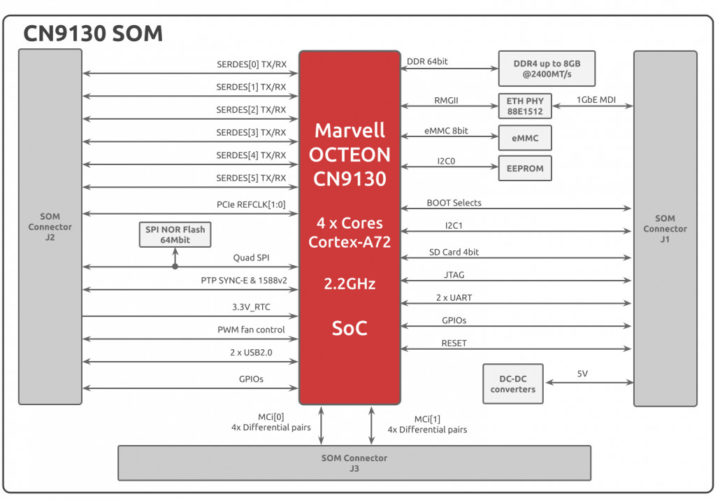
The parts shown with “via configurable SERDES” means they are multiplexed with other interfaces, so you’d have to select/configure the interfaces you’d like to use. The module can run Ubuntu, Debian, or OpenWrt using mainline Linux. More details about software support can be found on SolidRun developer’s website and source code on Github.
ClearFog CN9130 Pro
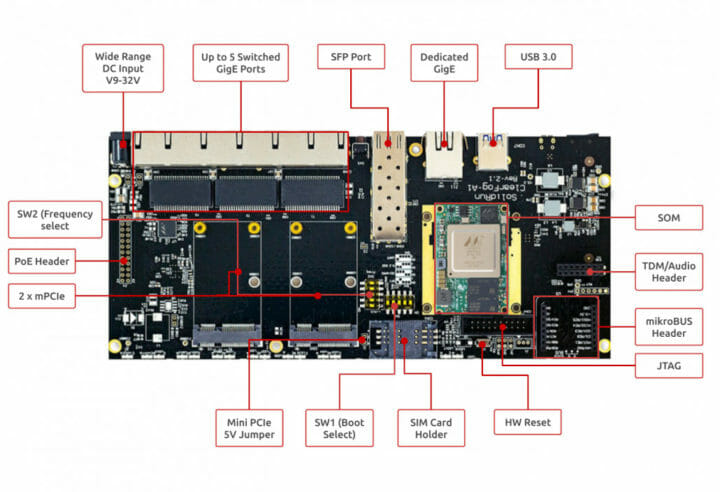
As one would expect the Pro version comes with more features with ClearFog CN9130 Pro board having the following specifications:
- SoM – SolidRun SOM CN9130 described above, but listed up to 4GB RAM since the 8GB version of the module is not available right now.
- Storage – MicroSD Card, M.2 2242 SSD socket
- Networking
- 1x “dedicated” Gigabit Ethernet RJ45 port
- 5x switched Gigabit Ethernet RJ45 port
- 1x SFP+ cage
- USB – 1x USB 3.0 port
- Audio – Analog Audio/TDM module support
- Expansion
- 2x mSATA/mPCIe socket with SIM holder for extra storage or wireless expansion modules
- mikroBUS header
- Debugging – JTAG Header, MicroUSB port
- Misc – Indication LEDs, user pushbuttons, RTC Battery, fan control, optional PIC microcontroller
- Power Supply – 9V-32V DC via power barrel jack, PoE header
- Dimensions – PCBA: 225 x 100mm; Extruded aluminum enclosure : 255 x 105 x 35mm
- Temperature Range – Commercial: 0°C to 70°C; industrial: -40°C to 85°C
ClearFog CN9130 Base
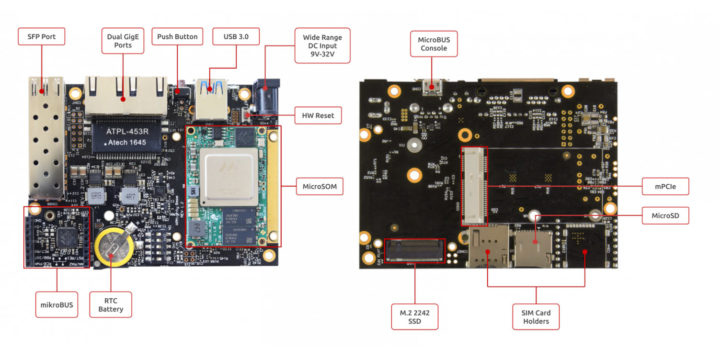
- SoM – SolidRun SOM CN9130 described above, up to 4GB RAM
- Storage – MicroSD Card
- Networking
- 2x Gigabit Ethernet RJ45 ports
- 1x SFP+ cage
- USB – 1x USB 3.0 port
- Expansion
- 1x mSATA/mPCIe socket with SIM holder for extra storage or wireless expansion module
- mikroBUS header
- Debugging – MicroUSB port
- Misc – Indication LEDs, user pushbuttons, RTC Battery
- Power Supply – 9V-32V DC via power barrel jack
- Dimensions – PCBA: 100 x 70mm; eExtruded aluminum enclosure : 120 x 80 x 30mm
- Temperature Range – Commercial: 0°C to 70°C; industrial: -40°C to 85°C
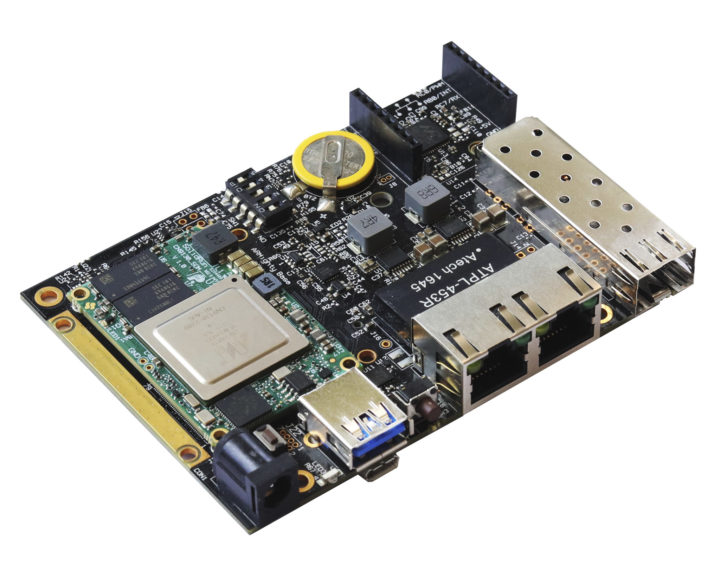
The ClearFog module and boards can be used to develop commercial and industrial intelligent networking, security, and edge computing applications such as 5G base stations, routers & gateways, edge servers, software-defined networking applications, as well as high-speed network storage applications
Pricing and Availability
SolidRun SOM CN9130 microSOM price starts at $171 with 1GB RAM, while ClearFog CN9130 Base is sold for $226 and up, and the Pro model for $253 and up. You’ll find all purchasing options on SolidRun online shop. Further information may be found on the corresponding SoM and SBC product pages.
Via LinuxGizmos

Jean-Luc started CNX Software in 2010 as a part-time endeavor, before quitting his job as a software engineering manager, and starting to write daily news, and reviews full time later in 2011.
Support CNX Software! Donate via cryptocurrencies, become a Patron on Patreon, or purchase goods on Amazon or Aliexpress


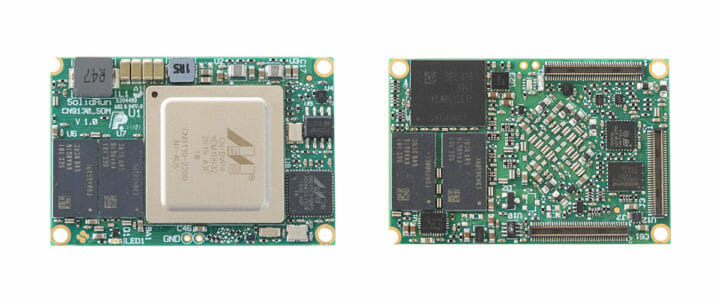
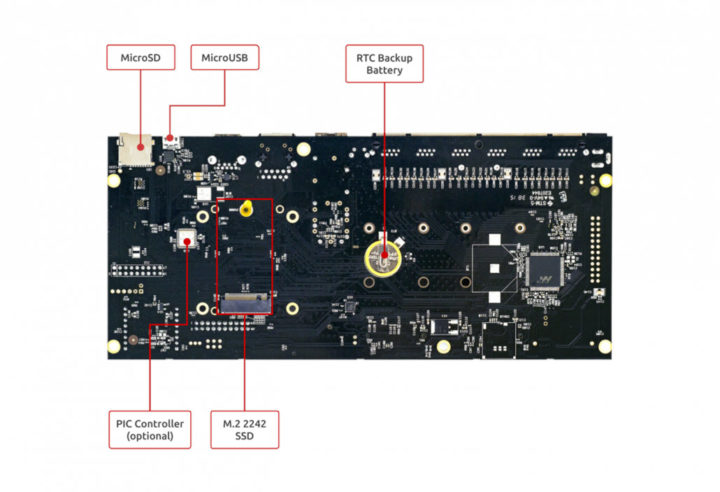




The CN9130 Base was listed “from” $149 on their website not long ago…
Welcome to 2021. The original pricing was projected cost at the time, the launch prices reflect cost changes in the supply chain.
2022 and 2023 will get pretty interesting. The amount of fabs they are currently building is insane. This is eventually flooding the market with fab availability.
It takes a long time to build fabs, high-NA EUV is delayed, and demand is expected to be heightened forever.
Hope for the best, expect the worst.
As a reminder: the TX2 CN91xx is newer version of the Armada 7040, while the Armada 8040 is the same CPU chip as the 7040 (ap807), but has two I/O chips (cp110) instead of one. The name is taken from the older but completely unrelated Cavium Octeon TX CN8xxx. What I had not realized is that there are no more eight-core designs in the Marvell lineage, the Armada 8080 no longer shows up on the Marvell website, and CN91xx is limited to four cores. There are larger TX2 CN92xx/CN96xx/CN98xx chips with up to 36 cores, but there is very little… Read more »
Yep indeed. I’ve been waiting for the 8080 for some time without ever seeing it. I guess they cancelled it when they started to consider acquiring Cavium. I thought the 91xx was a refreshed 8040 but I’m also fine with a 7040, not everyone needs all the I/O available in the mcbin 🙂 I just hope they reunified the L3 caches, because the ones in the 8040 are split per 2-cores. And yes my understanding of the TX2 family was that it was just a rebranding of the whole thunder-x2 family (except for the 91xx which allows them to continue… Read more »
Pretty sure the Octeon TX2 CN92xx/CN96xx/CN98xx is not just a rebranding or a cut-down version of ThunderX2 CN99xx, but a separate line of chips, unlike the Octeon TX CN8xxx, which was indeed a smaller cousin of ThunderX CN87xx/CN88xx. ThunderX2 was an Armv8.1 based server chip originally developed as Broadcom Vulcan, with ThunderX3 (Armv8.3) as its successor that never made it to the market. Octeon TX2 on the other hand seems to have the typical Cavium I/O from older Octeon TX and Octeon-III (MIPS) in combination with an unnamed Armv8.2 core. In theory, this core could be derived from the original… Read more »
Indeed you’re right, I didn’t notice such details, thanks for the precision. Then probably they’ve reused some work that was almost ready and unreleased yet (i.e. maybe a simpler intermediary step reached during the tx3 design phase). Anyway we cannot count on either cavium’s nor marvell’s verbosity to disclose the details there 🙂
This is awesome. I’ve been dreaming about this for a while. Basically the macchiatobin in the format of the clearfog. I do really love my clearfogs and the mcbin, but the mcbin is a bit heavy to carry everywhere in case I suddenly need 10G for some tests. I’m very tempted by ordering a CFBase now. However given that my two ordered Honeycombs have been staying in the “processing” state for the last 3 weeks, I guess they’re struck by the world-wide components shortage, and I don’t want to engage into yet another board that I’ll have to wait for… Read more »
Does anyone have an idea why they are still using msata/mpcie sockets? Hard to find anything to populate them nowadays.
Wi-Fi.
That said, the space isn’t going to allow for a 4×4 module.
Wifi nowadays is m.2 e key
Maybe 4g?
In laptops maybe, but not in routers.
Almost all of the 4×4 modules are mPCIe
I think they almost didn’t change the original layout and I would not even be surprised if the older SOMs could be installed on the new boards (with limited capabilities of course), to reduce the number of references in stock.
Probably
So it indeed looks like it’s exactly the same SOM and that both are compatible with the same base board (maybe the base board was slightly updated, I don’t know): https://developer.solid-run.com/knowledge-base/clearfog-base-getting-started/
I’m curious whether the base board permits running the GigE ports at 2.5G or if the transceiver limits this. Anyway all this makes the board even more interesting!
that explains why it makes such bad use of the CN9130’s I/O :